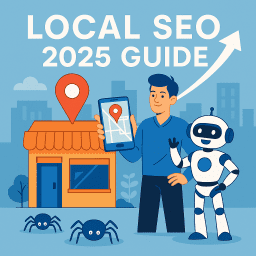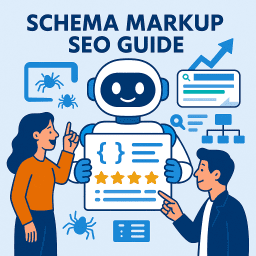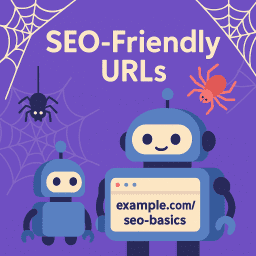Complete SEO Strategy Guide 2025: From Planning to Rankings
From goals to rankings: a full roadmap for SEO success

🧭 Your Roadmap to Building a Winning SEO Strategy
🧭 SEO can feel like a maze — full of algorithms, shifting rules, and endless advice. But what if you could start with a clear, structured plan?
This guide walks you through exactly how to build a complete SEO strategy from scratch in 2025. Whether you’re a business owner, marketer, or solo entrepreneur, this post is your blueprint for creating a search engine strategy that actually works.
🎯 1. Define Your SEO Goals
Before diving into keywords and content, you need to know what success looks like. Your SEO strategy should align with broader business objectives.
- 📈 Do you want more organic traffic?
- 🛒 Are you aiming for more leads or conversions?
- 🧑💼 Are you trying to build thought leadership?
- 🌍 Are you expanding into a new market or geography?
Set SMART goals (Specific, Measurable, Achievable, Relevant, Time-bound) to track your success.
Example: “Increase organic traffic to the blog by 30% within 6 months.”
🧑💻 2. Know Your Audience
SEO isn’t just about pleasing Google — it’s about understanding and serving your audience. Start by creating detailed audience profiles:
- 👤 Who are they?
- 📍 Where are they located?
- 📱 What are their pain points?
- 🧠 What kind of content do they prefer?
Use tools like Answer the Public, SparkToro, or Semrush Market Explorer to discover what your audience is searching for — and what language they use.
🔍 3. Conduct a Competitor Gap Analysis
Analysing what your competitors rank for can uncover untapped opportunities and blind spots in your current strategy.
Use tools like:
- Ahrefs Content Gap Tool
- Semrush Keyword Gap Tool
- SEOptimer
Look for:
- 🔎 Keywords your competitors rank for that you don’t
- 🔗 Their most linked-to pages
- 📄 Content formats they use (guides, reviews, tools)
- 📊 Domain authority vs yours
🔑 4. Build a Keyword and Topic Strategy
Once you know your goals, audience, and competitors, it’s time to dive into keyword and topic selection. But don’t just chase search volume — focus on search intent.
Use a mix of:
- 🌱 Short-tail keywords: e.g. “SEO tools”
- 🌳 Long-tail keywords: e.g. “best free SEO tools for beginners 2025”
- 🔄 Evergreen topics: always relevant
- 🔥 Trending topics: seasonal or topical
Organise your findings into topic clusters — one main “pillar page” supported by several in-depth pages on related subtopics.
🗂️ 5. Plan Your Content Calendar
Consistent, quality content is at the heart of any SEO strategy. Use your topic clusters to build a content plan that covers:
- 🗓️ Publishing frequency (e.g. 2 posts/month)
- 🧠 Content type (how-tos, comparisons, case studies)
- 📌 Assigned keyword focus per post
- 🔗 Planned internal links
Include different content types for full-funnel coverage:
- 🎣 Top of funnel (ToFu): Informational blog posts, tips
- 🛤️ Middle of funnel (MoFu): Case studies, comparisons
- 🛍️ Bottom of funnel (BoFu): Product pages, testimonials
🏗️ 6. Set Up Technical SEO & Site Structure
Even the best content won’t rank if Google can’t crawl or index your site. Address key technical SEO tasks:
- 🧭 Clear navigation and URL structure
- ⚙️ Fast page load times (check Google PageSpeed Insights)
- 🔐 HTTPS security
- 📱 Mobile-friendliness
- 🗺️ XML sitemap and robots.txt
Use Screaming Frog or Sitebulb to audit your site structure and technical setup.
📈 7. Measure & Report SEO KPIs
SEO without tracking is like flying blind. Define which KPIs matter most for your goals:
- 📊 Organic traffic (via Google Analytics)
- 🔍 Keyword rankings (track with Serprobot or RankMath)
- 📥 Conversions (form submissions, sales, downloads)
- 💡 Engagement metrics (bounce rate, time on page)
- 🧩 Index coverage and Core Web Vitals (via Google Search Console)
💡 Set up a monthly or quarterly reporting system. Include insights, not just data: What’s working? What needs improvement?
💬 What the Experts Are Saying
“An SEO strategy without audience understanding is just shouting into the void.” — Areej AbuAli
“Good SEO is 20% knowing the tools, 80% knowing your user.” — Rand Fishkin
“Your strategy should evolve — but your structure should always support it.” — Lily Ray
📝 Recap and Clarify: Post-Specific FAQs
What’s the first step in building an SEO strategy?
Start with clear, measurable goals. Decide whether your focus is on traffic, leads, visibility, or conversions — then build everything else to support that.
Do I need to write blog posts to have a strategy?
Not necessarily. You can use landing pages, product pages, FAQs, case studies, or tools. But content is essential — you need valuable, indexable pages to rank.
How long does it take to see SEO results?
Most strategies start showing results in 3–6 months, but it depends on your niche, competition, domain age, and effort. SEO is a long-term investment.
📝 Final Thoughts
Building a solid SEO strategy in 2025 requires more than a checklist of tactics — it demands a thoughtful, adaptable approach that aligns with your audience’s needs and Google’s evolving standards.
From setting clear goals and understanding search intent, to planning content, optimising technical elements, and measuring meaningful KPIs, every part of your strategy should work together to create long-term value. The most successful sites are those that focus on users first, delivering helpful, relevant experiences that naturally earn visibility in search.
Remember, SEO is not a one-off project. It’s an ongoing process of learning, testing, and improving. Strategies that worked last year may need refining today as search landscapes shift and new technologies like AI-powered search reshape how users find information. Stay flexible, monitor performance, and always be ready to adjust. By focusing on quality, trust, and usability, you’ll not only achieve better rankings but also build a digital presence that stands the test of time. Success in SEO comes to those who plan carefully, act deliberately, and put users at the heart of everything they do.
“Your SEO strategy is your map. Without it, all you’re doing is guessing.” — David Roche

















